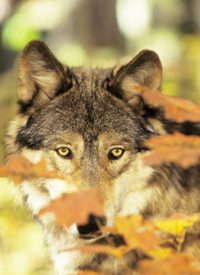
On Wednesday, April 6, the Idaho Senate followed suit, passing the bill 27 to 8.
The legislation declares "the state's citizens, businesses, hunting, tourism and agricultural industries, private property, and wildlife, are immediately and continuously threatened and harmed by the sustained presence and growing population of Canadian gray wolves in the state of Idaho." The bill finds that "the population of gray wolves in Idaho, having been introduced into the state in 1995, over the united objection of the Idaho congressional delegation, Idaho legislature, Idaho governor, Idaho counties and numerous Idaho agricultural groups who were gravely concerned with the negative effects this action would impose on Idaho and Idahoans, is now many times exceeding the target number originally set by the federal government and the number set in Idaho's federally-approved 2002 wolf management plan."
Authored by House Speaker Lawerence Denney, the legislation notes:
The U.S. fish and wildlife service (USFWS) has delisted the gray wolf in Idaho in 2008 and 2009 returning management to the state, only to be sued both times by environmental groups forcing the wolf to be relisted as endangered. As a result of all the above, the legislature finds that public safety has been compromised, economic activity has been disrupted and private and public property continue to be imperiled.
"The uncontrolled proliferation of imported wolves on private land has produced a clear and present danger to humans, their pets and livestock," says the bill, "and has altered and hindered historical uses of private and public land, dramatically inhibiting previously safe activities such as walking, picnicking, biking, berry picking, hunting and fishing. The continued uncontrolled presence of gray wolves represents an unfunded mandate, a federal commandeering of both state and private citizen resources and a government taking that makes private property unusable for the quiet enjoyment of property owners. An emergency existing therefore, it is the intent of the legislature to regulate the presence Canadian gray wolves in Idaho in order to safeguard the public, wildlife, economy and private property against additional devastation to Idaho's social culture, economy and natural resources, and to preserve the ability to benefit from private and public property within the state and experience the quiet enjoyment of such property."
Predictably, the legislature's action sent wolf advocates in the media and the enviro-activist ranks into a tizzy. The Idaho Statesman editorial board, in its "Our View" column, opined that the Denney legislation is the work of "Statehouse scientific charlatans," and derisively caricatured Rep. Judy Boyle, a cosponsor, as "the Statehouse Little Red Riding Hood."
"Wolf attacks are extremely rare," says the Statesman " — and certainly in relation to the region's population of fearmongering political panderers." The Statesman, however, is not averse to a little unstatesmanlike fearmongering and pandering itself — as long as it is in the service of the left-wing political agenda du jour, such as, for instance, saving the world from the alleged "crisis" of global warming (aka climate change). The Statesman prefers to be frightened by (and to frighten its readers with) Al Gore's imaginary tidal waves supposedly caused by the carbon footprints of industrial miscreants and cud-chewing ruminants. However, for the many Idahoans who live and work and recreate outside of the protected urban enclaves that are the habitat of the Statesman's editorialists, the rapidly expanding wolf population is a dangerous fact, not fiction. Elk herds already have been devastated in many parts of the state, as have the populations of moose, sheep and other wildlife. Cattle, sheep, horses, and other livestock, as well as pets are under increasing attack.
Protected, the wolf population has exploded and wolves have dramatically expanded their ranges. They are becoming habituated to humans and are losing their fear of man, as a number of incidents in Idaho illustrate:
* Pack Threatens Women — Karen Calisterio, who lives near Tensed, a small town of 124 along U.S. Highway 95 between Coeur d'Alene and Moscow (home of the University of Idaho) had a frightening confrontation with four wolves as she walked up the drive to her home from the main county road on November 27, 2010.
Fighting off panic and the urge to turn and run, she backed away and frantically called her husband and the next-door neighbor on her cellphone, as the wolves closed in on her. Her husband's vehicle slid off the road in the heavy snow as he attempted to race to her rescue. She was sure she was a goner, she says, but thanks God that her neighbor arrived in the nick of time in her 4-wheel drive. Mrs. Calisterio recounts her harrowing ordeal in this video interview.
Two weeks before Mrs. Calisterio's wolf encounter, her friend and neighbor, Pamela Secord, had a similarly unnerving confrontation with the wolves.
* Hunting the hunters — Idaho resident Jason Smith along with his two partners and a guide were hunting elk along the Selway River last October when a large pack of wolves closed in on them from 40-50 feet away. Multiple gunshots aimed near them failed to scare the animals, which continued dogging the men, yipping and howling as the hunters retreated back to camp. We reported here last November regarding a similar experience by two elk hunters along the Flathead River in neighboring Montana. In that case a pack of seven or eight wolves chased the hunters and their horses a considerable distance, even though they repeatedly fired their guns and even shot and killed one of the attacking predators.
* Stalking children — Last year near the town of Kamiah, along the Clearwater River, Mike Popp was picking up his two elementary school children from the bus stop when he saw three wolves watching the kids from 30 feet away.
This is similar to experiences reported in Arizona and New Mexico, where wolves have become habituated to humans and are now seen prowling near playgrounds and schools.
It is not a question of if, but only a matter of when tragedy will strike, in the form of fatal wolf attacks on humans in Idaho and other states with proliferating wolf populations. As we have reported previously in The New American, this is already happening in Alaska, Canada, Russia, Georgia, Ukraine, and elsewhere.
Dr. Valerius Geist, a renowned biologist/ethologist and professor emeritus of Environmental Science at the University of Calgary is one of the world's leading wolf experts. He believes that the popular urban myth of the wolf as a cuddly benign canine is dangerous disinformation that has already been responsible for several tragic deaths (such as Kenton Carnegie, Trisha Wyman, Candice Berner, and Sandra Piovesan). He sees more tragedy looming on the near horizon.
According to Professor Geist, there are seven stages leading to an attack on people by wolves, which we abbreviate and paraphrase below:
1) Wild game becomes scarce and game — deer, elk — begin moving into urban, suburban, and farm/ranch areas for protection against wolf predation;
2) Wolves begin approaching human habitations at night and are heard howling even during the day;
3) Wolves begin to frequent human habitations in daylight hours, and observe people and livestock at a distance;
4) Wolves become bolder, attacking small livestock and pets during daylight, sometimes pursuing their prey onto verandas. At this stage the wolves do not attack humans, but will growl and act threateningly toward them;
5) Wolves begin attacking large livestock and may follow riders, as well as mount verandas and look into windows;
6) Wolves make hesitant, clumsy attacks on people, nipping at clothing, limbs, torso; people often misinterpret these acts as playful gestures, but the wolves are probing, learning;
7) Wolves begin attacking people in predatory fashions.
Says Professor Geist:
A mature, courageous man may beat off or strangulate an attacking wolf. However, against a wolf pack there is no defense and even two able and armed men may be killed. Wolves as pack hunters are so capable a predator, that they may take down black bears, even grizzly bears.
Even experienced hunters and outdoorsmen have been amazed in recent years at the enormous size of some of the Canadian Grey Wolves that are showing up in the western states. Male wolves can weigh upwards of 170 lbs., twice the size of a large German shepherd, as these photos (here, here, and here) of recent specimens show. A specimen of that size can develop bone-crushing jaw pressure exceeding 1,500 lbs. per square inch, double that of a German shepherd.
Fred Desjarlais, a very strong 55-year-old, 5'9" Saskatchewan miner was able to grapple with and fight off a 100-lb wolf, until his co-workers came to his assistance. But it is unlikely that he (or even Hulk Hogan) could do the same with a Canis Lupus that weighed in at the 170-lb range. And as Dr. Geist points out, he wouldn't have had even a ghost of a chance against a pack of determined, human-habituated wolves. Women, children, and the elderly are completely vulnerable.
The Statesman airily dismisses these concerns and says the state "can find more pressing matters of public safety – especially since the wolf population may already be in decline." To buttress this dubious point, the editorial quotes the same misleading statistics cited by other media wolf promoters: "According to U.S. Fish and Wildlife Service estimates, Idaho was home to an estimated 705 wolves in 2010, down from 870 a year earlier."
If this extremely suspect lowball number is true, it is an admission, nevertheless, by the USFWS that the wolves have already attained more than seven times the number of 100 wolves and 10 breeding pairs needed for a sustainable wolf population, as agreed upon federal government and the states when the non-indigenous species was introduced in 1995.
The Statesman's editorial collective seems to be attempting a fig-leaf covering of the doubtful numbers with this curious admission: "The feds say the lower numbers could have been caused, in part, by reduced monitoring efforts in Central Idaho's remote mountains, and the loss of some radio-collared wolves."
In other words, "the feds" (who, along with the radical "green" activists, have been continually upping the ante on the number of wolves needed for "sustainability") admit that maybe their lower figures are the result of a failure of competence or will on their part to accurately count the wolves.
"Yes, the science is imprecise," says the Statesman. "But it isn't on the side of the legislators who cry wolf."
It certainly is not on the side of the Statesman's editorialists, the USFWS, or the full-time wolf activists funded by EarthJustice, World Wildlife Fund, Natural Resources Defense Council, Sierra Club, and the Center for Biological Diversity.
As The New American has reported previously (here and here), reputable biologists challenge the USFWS wolf population statistics and credibly suggest it is double, triple, or quadruple the official count. Wolves are prolific, capable of population increases of 30-50 percent per year. The world's top wolf experts seem to be in agreement that it is not even in the interest of the wolves, as a species, to allow them to multiply unnaturally in their current protected status. Even some of the most avid wolf advocates — such as Ed Bangs, U.S. Fish and Wildlife Service wolf recovery coordinator for the Northern Rockies, and Professor David L. Mech, founder of the Minnesota-based International Wolf Center — agree that unless wolves are hunted they will soon outstrip their habitats.
Spreading disease
While most of the public concern over the danger presented by wolves has naturally focused on the threat posed by the potential for actual physical attacks by these large carnivores on people, livestock, and pets, there is another more far-reaching threat that is less appreciated and understood. Wolves are well-known as carriers of a multitude of diseases and parasites (see here, here, and here), including rabies, brucellosis, anthrax, tularemia, Canine coronavirus, Trichinella spiralis, Neospora caninum, tapeworms, nematodes, and ticks. Because wolves regularly range over great distances, they are very efficient vectors for spreading these diseases and parasites. According to one report, two-thirds of Idaho wolf carcasses examined were infected with hydatid disease tapeworms. This vector danger in itself is more than sufficient to warrant the state legislature's call for emergency measures.
The emergency legislation now goes to the desk of Gov. C.L. "Butch" Otter, who is expected to sign the bill.
Related articles:
Wolf Attack! “Without our Horses and Guns We Would Be Dead”
NatGeo’s “Wolf Wars” Flacks for Radical Greens



